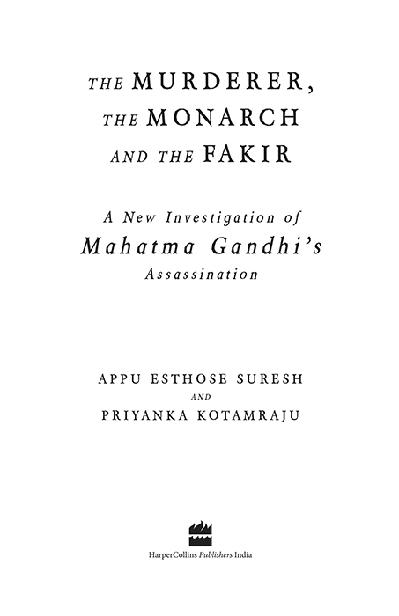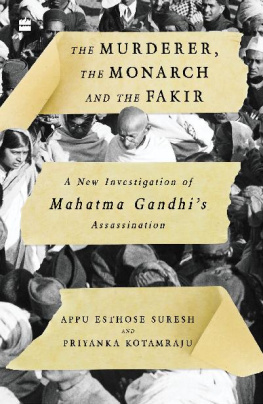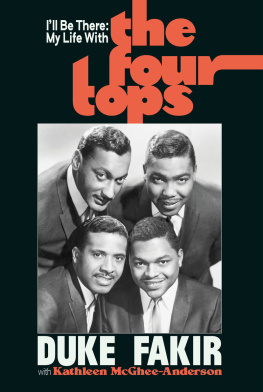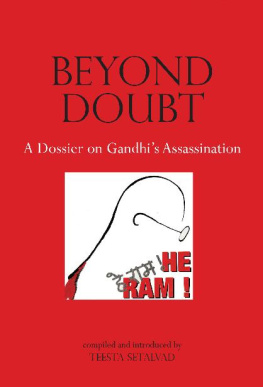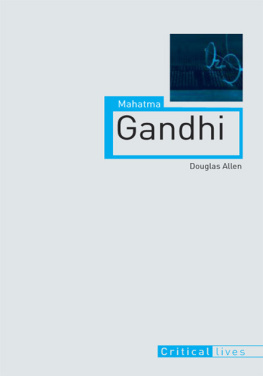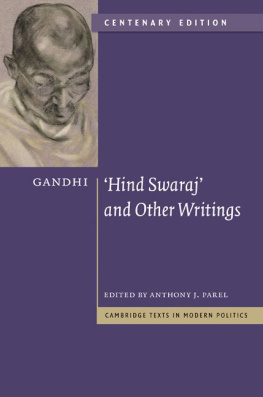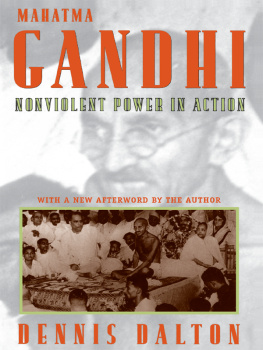To all the unnamed sources.
And to all our teachers.
O N 30 January 1948, Mahatma Gandhi was assassinated by a fanatic, Nathuram Godse, because he disagreed with Gandhijis conviction that Hindus and Muslims should live together in harmony.
Arguably modern Indias biggest political development, the assassination of Mahatma Gandhi finds a desultory mention in our school history textbooks. These lines from the National Council of Educational Research and Training (NCERT) textbook were the closest I got to understanding a pivotal moment in Indias history. History, for me at least, was taught as a collection of bald facts. We learned dates, events and names of people, and hardly anything else. Despite its rather anodyne presentation in our texts, history fascinated me; in fact, it still does.
I joined St. Stephens college in New Delhi for my graduation. I was a resident of the Rudra North Block residence hall, which was named after the first Indian principal of the collegeand perhaps the first Indian principal of a missionary college anywhereSushil Kumar Rudra. Suddenly, history became part and parcel of everyday life. As a fresher (or fuchcha in university parlance), the initiation process involved me getting to know everything about the college, my dorm, its previous occupants, even the number of trees on the campus. Possession of these historical facts guaranteed my safe passage into the college brotherhood. What I didnt realize then was that these silly rites of passage had brought me closer to knowing Mohandas Karamchand Gandhi than ever before.
That C.F. Andrews, also known as Deenabandhu, was instrumental in bringing Gandhi from South Africa to India was just another interesting but incomplete factoid from our textbooks. It was only after joining the college that I began to realize the enormous significance of this. In 1913, S.K. Rudra sent his vice-principal C.F. Andrews to South Africa to persuade Gandhi to return to India. Andrews spent six months there, eventually succeeding in his mission. When Gandhi arrived in Delhi, it was Rudras home that offered him shelter, despite the misgivings of and warnings by the imperial government. It was under Principal Rudras roof that Gandhi shaped the Khilafat movement and the non-cooperation movement.
In 1925, Gandhi wrote, The reader may not be aware that my open letter to the Viceroy, giving concrete shape to the Khilafat claim, was conceived and drafted under Principal Rudras roof. He and Charlie Andrews were my revisionists. Non-cooperation was conceived and hatched under his hospitable roof. It was also thanks to Andrews that Gandhi met Rabindranath Tagore and became great friends. Piecing together these nuggets one by one brought me closer to understanding the overarching arc of history of Delhi and India at the time.
Despite its pivotal role in shaping modern Indian history and its deep association with Gandhi, St. Stephens had let dust settle on these chapters. The Gandhi Study Circle (GSC), which was one of the oldest student societies, was practically defunct when I joined. In hindsight, the GSCs inactivity was in some ways a reflection of what has happened to Gandhi and Gandhian thought in modern India. I was fortunate enough to be one of the small group of students who revived this society in our college. We got K.P. Shankaran, then head of the philosophy department, as its staff advisor. This was a big deal, because K.P. Shankaran is an authority on Gandhian thought and political philosophy. Over the years, we have had many exchanges on Gandhi. One particular conversation comes to mind, which forms the foundational inquiry of this book. You have to ask yourself which Gandhi you are investigating If you read Godses reasons for assassinating Gandhi, hes talking about an entirely different entity. Godse killed a man who he thought was a traitor to his faith and his peoplesomeone who did not support the Indian state and was an anti-national.
Shankaran said that the Gandhi who is the Father of the Nation is a construction of the Government of India and modern Indian historians of all persuasionsleft, right, and centre. According to him, Gandhi was against the formation of the Indian state. He was not a religious person, but he used Hindu vocabulary to get ordinary Hindus to practise what he called an ethical religion. Shankaran also posited that the issue of Hindu masculinity should be understood in the context of Gandhis rejection of the Indian population as cowards and therefore unethical. Gandhi has a very significant theory which links fear and an unethical life. Unethical life here means preoccupation with oneself. He asked me to carefully listen to V. Madhusoodanan Nairs poem on Gandhi.
We are not historians, or philosophers, or poets. But Nairs poem, even to the untrained ear, is a powerful portrayal of the many Gandhis we might claim to know. One Gandhi is the man who walks alone on a path so difficult that even his followers, the anugami, fail to accompany him. There is another Gandhi, the one who fell into a burning clay pot of his own makingperhaps this refers to the Gandhi who strove for religious pluralism all his life to fall to the bullet of a religious fanatic. Then there is the Gandhi who springs up occasionally from the pages of our history books as the Father of the Nation or the architect of a national movement. There is the Gandhi who marched to Dandi as an act of civil disobedience to teach us to be our own masters and unshackle ourselves from slavery. There is also the Gandhi who was a flicker of light that remained undimmed in all weathers; indefatigable and steadfast in a purpose that he alone best understood. At one point, the poet asks if Gandhi is a dream or a story we might have heard, because of how implausible his goals were. Who is/was Gandhi? The one who sparked love and admiration in millions? The one who willingly sacrificed his frail body for satyagraha? The one who was able to tame the wildest among the Indians of his time and bring them together? Or is Gandhi the one who absorbed the trauma and shattered hopes of hundreds and thousands of people? There is that Gandhi for whom God is not Rama or Christ or Allah; God is love. In the final denouement, Nair writes that there may be multiple ways of knowing and seeing him, but Gandhi transcends even those expectations and perceptions. It does not matter how we write or rewrite him; he is what he is.
I repeated parts of this conversation to one of my sources, who was an erudite third-generation bureaucrat with a keen memory for details. He told me that several years ago he had seen a picture of the Maharaja of Alwar, whose nails had grown rather long, in house arrest imposed by then Home Minister Sardar Vallabhbhai Patel. The senior bureaucrat believed that the gun that killed Gandhi came from the Alwar armoury. This turned out to be one of the many conspiracies about the assassination, best classified as unverifiable rumours. There, in March 2013, began my search for the gun that killed Gandhi. This anecdote rekindled my interest in Gandhi, especially in the reasons for his murder, and the involvement of all the actors in the conspiracy. As a journalist, I had some idea that the political climate was also about to change, which only increased my curiosity.
I went about this story just as I would pursue any other investigation. The first hurdle for me was the discovery that no one repository housed the Gandhi assassination files; they were scattered haphazardly between the National Archives of India and the Nehru Memorial Museum Library (NMML). As an investigative journalist, my routine was to go beyond what was publicly available, be it documents, file notations or conversations. I wanted to know facts about the assassination that were not publicly accessible. The National Archives and NMML were great starting points. A third great source was the Jeevan Lal Kapur Commission report. This commission of inquiry came about because of a statement issued by G.V. Ketkar, the editor of Tarun Bharat , former editor of Kesari and grandson of freedom fighter Bal Gangadhar Tilak, in 1964. He was speaking on the occasion of a meeting organized to felicitate Gopal Godse and Vishnu Karkare on the completion of their jail term for their role in Gandhis assassination. According to an Indian Express report of 14 November 1964, Ketkar claimed that he had known about the assassination plot many weeks in advance, a statement he later revised from knowing about the actual plot to knowing about the intention. The Kapur Commission report contained many details and its exhibits were a great source. However, the commission focused more on the lapses in the probe. Sure, it did bring out the fact that V.D. Savarkar, the Hindutva icon who was acquitted for lack of evidence, was in touch with those who were directly involved in the assassination plot before it was carried out. Savarkars bodyguard Appa Ramachandra Kasar and secretary Gajanan Vishnu Damle did reveal this to the Bombay police, but it was never brought to trial. Had this evidence been presented during the trial, the outcome of it might have been different.
